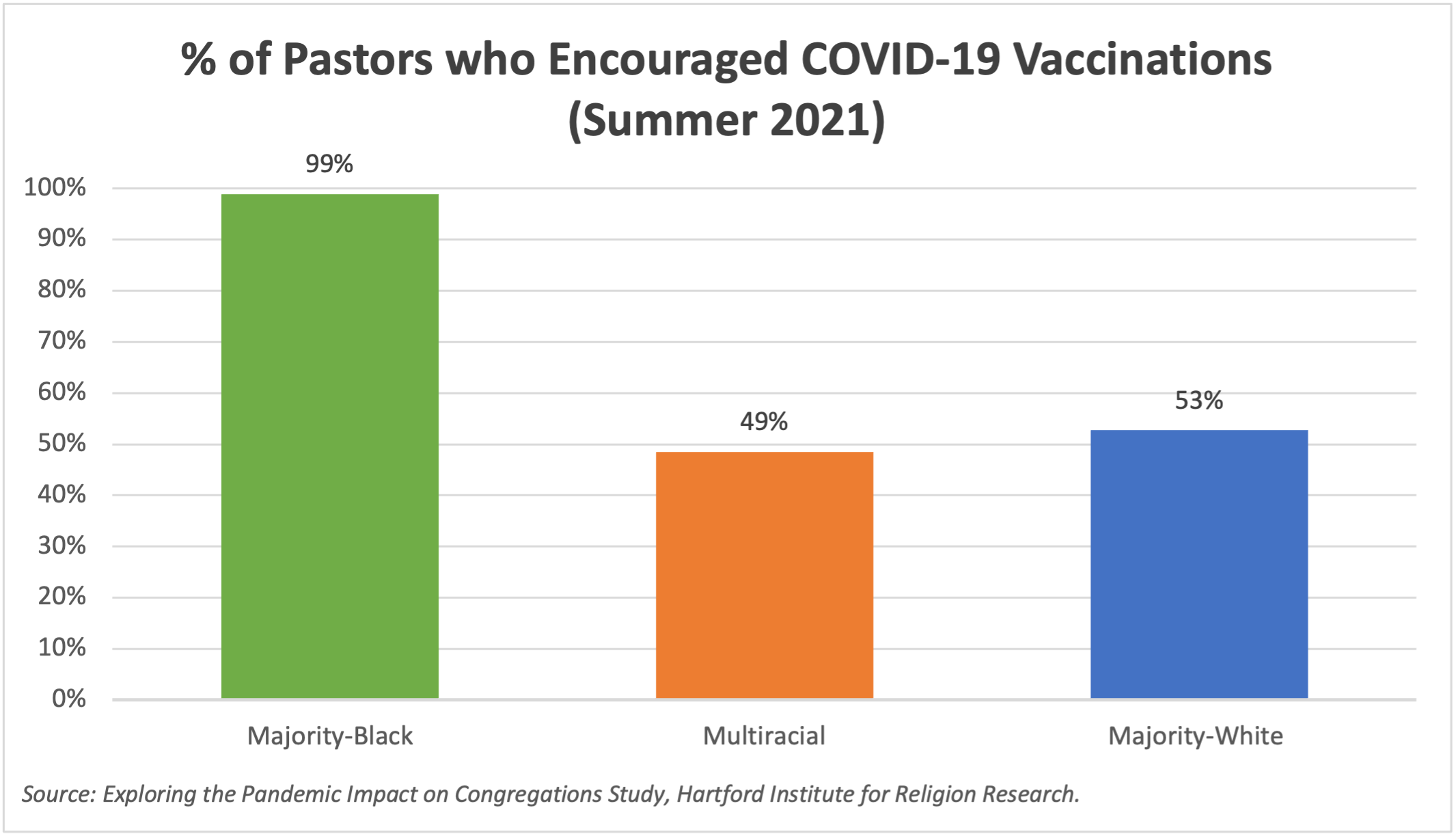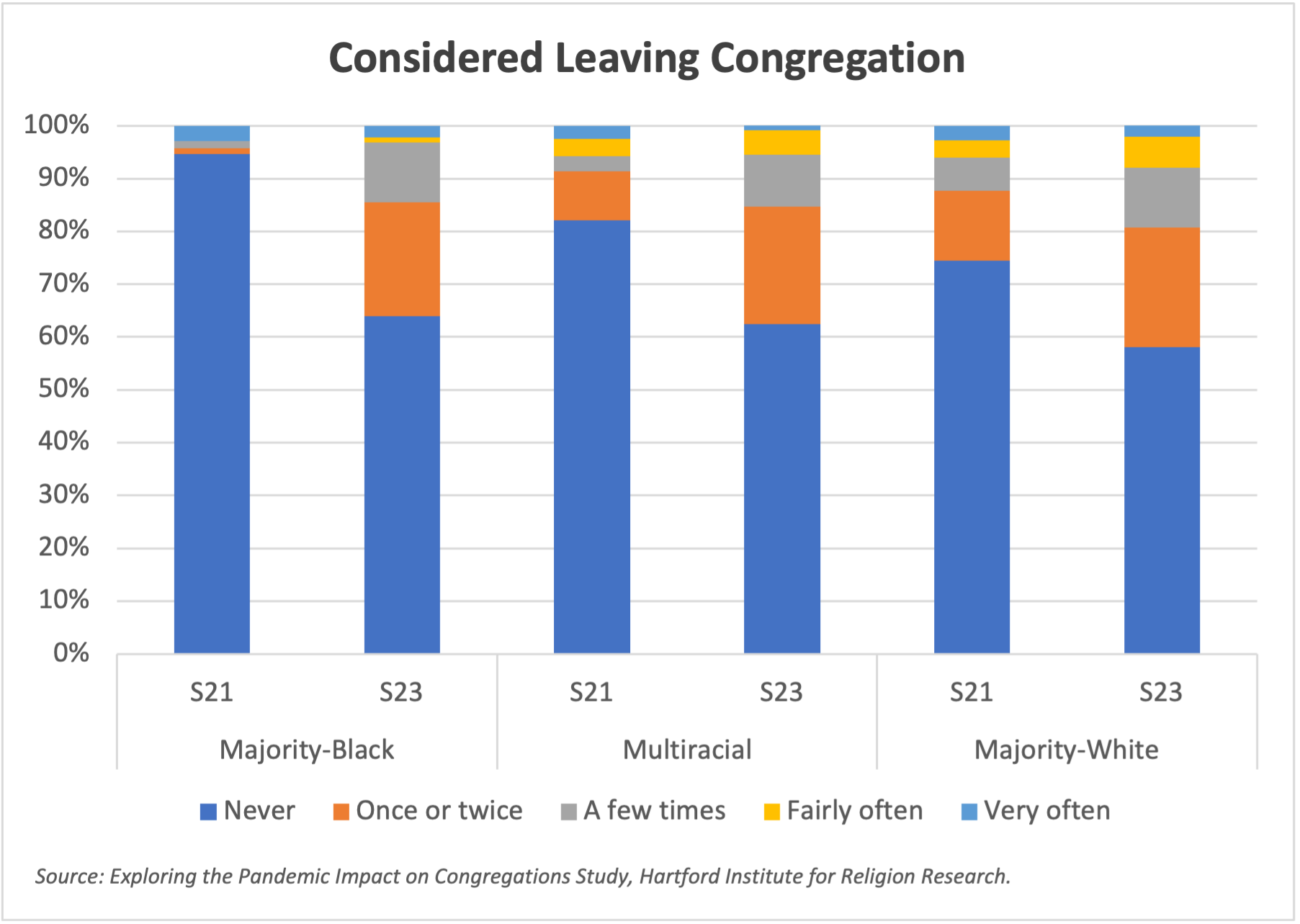COVID hit Black congregations especially hard in the pocketbook, pew and pulpit. But they have managed to outdo white churches in promoting wellness and vaccines, according to a new report by the Hartford Institute for Religion Research.
Black congregations also emerged from the COVID pandemic strongly embracing hybrid forms of programming, worship and activities even as challenges remain. But “majority-Black congregations have been hit particularly hard on financial stability issues, and Black clergy are experiencing a greater decline in well-being,” the Hartford Institute said
The report — “Understanding the Pandemic Impact on Black and Multiracial Congregations” — is the latest installment in Exploring the Pandemic Impact on Congregations, a five-year study funded by the Lilly Endowment to gauge the long-term effects of the pandemic on religion in America.
The report demonstrates how unevenly the pandemic has affected social groups, researchers said.
“Many news outlets have reported that Black, Brown, and Indigenous people of color (BIPOC) are more likely to be exposed to COVID-19 due to being more likely to work in service or retail jobs but are also more likely to be COVID ‘cautious’” or continuing to wear masks and social distancing when possible, the report, released Jan. 4, said.
It documents how race influenced congregational reactions to the challenges posed by pandemic. It relies upon data taken from the Faith Communities Today 2020 study and previous Exploring the Pandemic Impact on Congregations reports.

The earlier studies consistently showed pandemic-induced declines in church involvement and attendance occurred across racial categories.
Multiracial churches experienced the biggest drop in attendance — from an average of 80 pre-pandemic attenders to 37 by fall 2021. In that period, Black church attendance declined from 60 to 45, and in white churches, the number of attenders fell from 70 to 33, according to the report.
“The percentage of new attenders also dropped steeply across all groups due to the pandemic.”
“The percentage of new attenders also dropped steeply across all groups due to the pandemic. By summer 2021, new attendees represented less than 10% of majority-white and majority-Black congregations; even multiracial congregations dropped below 10% by fall 2021. Nevertheless, there was an increase of almost double across congregations by spring 2023.”
Volunteers also fell off during the worst months of the pandemic, researchers added. Before COVID-19, steady volunteers stood around 40% of the congregation in white and multiracial churches, and at about 30% in Black churches. During the summer of 2021, the percentages dropped to 20% in white churches, 15% in multiracial churches and 6% in Black churches.

“As of spring 2023, Black congregations are seeing numbers similar to pre-pandemic at about 30%, whereas multiracial and majority-white congregations have not fully recovered, hovering around 35%,” the report said.
The pandemic also affected worship unevenly. By the summer of 2021, most churches stopped offering in-person worship due to the pandemic. Only 5% of multiracial churches held such services throughout the pandemic, versus 7% of Black and 15% of white congregations, the study found.
Almost two years later, Black churches were the least likely to gather only in person, with 15% doing so. By comparison, 25% of both multiracial and white churches exclusively offered in-person service.
“Hybrid worship — featuring both in-person and virtual worship — remains the most utilized worship mode,” the report said. “Hybrid worship — featuring both in-person and virtual worship — remains the most utilized worship mode, with 83% of majority-Black congregations engaged in hybrid worship, while 75% of majority-white and multiracial congregations do so.”
Data collected earlier this year found 41% of Black congregations host hybrid prayer meeting, which is “approximately four times the rate of multiracial and majority white congregations,” the report said. “This may highlight the zealousness to gather, and especially for prayer, which remains a frequent practice and coping mechanism among Black adults.”
Black churches also stood out when respondents were asked if their pastors promoted vaccinations when the injections became available in 2021. According to researchers, 99% of pastors of Black congregations encouraged the use of vaccines, compared to 53% of pastors in white and 49% in multiracial churches.

Black congregations, at 15%, opened their buildings for use as centers for administering COVID-19 tests and vaccines, compared to 9% of multiracial and 4% of white congregations, the study said.
“Black churches have historically been leaders in civic engagement, especially regarding health (i.e., cardiovascular disease prevention workshops, breast cancer screenings, etc.). Another factor may be awareness of the impact of COVID-19, particularly on BIPOC communities,” it noted.
While congregations of all types suffered financially due to COVID, Black congregations especially took it on the chin during the pandemic, researchers said.
“In summer 2021, there was an increase in donations from congregants across all three racial groups. However, by fall 2021, fewer congregations saw an increase in donations, particularly with majority Black congregations at a 33% decrease.”
“Majority-Black congregations still seemed to struggle to reach financial stability.”
The report found 49% of white churches reported unchanged financial health from 2018 to 2023, compared 41% of Black congregations.
“Majority-Black congregations still seemed to struggle to reach financial stability,” the report said. “This cycle of instability and dependence speaks to the systemic issues facing majority-Black congregations and the intersections of race and socioeconomic class.”
Earlier this year, survey results documented a decline in well-being among clergy in Black and multiracial congregations. “This might indicate that the stress on majority-Black and multiracial congregations is taking a toll on these religious leaders,” the report observed.
Declines in mental health levels notwithstanding, 83% of Black clergy said they “never” doubt their calling to ministry, versus 72% of white and 62% of multiracial ministers.

“On the other hand, when asked about thoughts of leaving the congregation, leaders of congregations across all racial groups were more likely to have these thoughts in 2023 compared to 2021,” the study added. “Clergy of majority-Black congregations went from 95% who ‘never’ considered leaving their congregation in summer 2021 to 64% in spring 2023.”
In 2021, about 55% of clergy serving white churches said they never would leave ministry, compared to about 49% who said that in 2023. Among ministers in multiracial churches, those stating that commitment declined from about 65% to about 42% during the same two-year period.
Related articles:
Florida surgeon general spreads more doubts about COVID vaccines
Most comprehensive study yet of COVID’s impact on churches finds uneven results
Post-COVID, U.S. hunger and poverty rates are soaring


